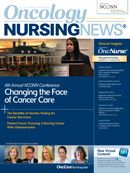A Surgeon's Perspective on GI Cancer Navigation
For Johns Hopkins' gastrointestinal cancer surgeon Mark Duncan, MD, those who help his patients to cope with their diagnosis and manage their often complex treatment and follow-up are critical members of the healthcare team.
Mark Duncan, MD
For Johns Hopkins’ gastrointestinal cancer surgeon Mark Duncan, MD, those who help his patients to cope with their diagnosis and manage their often complex treatment and follow-up are critical members of the healthcare team—be they nurse practitioners, oncology nurses/navigators, or, as in his case, a physician’s assistant. In fact, as he told attendees at NCONN 2012, he would like to see more GI nurse navigators for a specialty where currently there are not enough.
Gastric cancers represent the second leading cause of cancer deaths worldwide, noted Duncan, associate professor of surgery and Oncology at the Johns Hopkins University School of Medicine and vice-chair of the Department of Surgery. Regardless of the tumor type, “surgery is front and center in these cancers,” and is frequently followed by some complication. At least initially, “all of my patients will lose weight,” and we have to ask ourselves, “if they don’t start to gain weight, is that the effects of surgery, or do they still have cancer?”
“With the tumors I treat, I don’t save most patients, but I treat all.” In getting them back on their feet, “a lot depends on the patient.” His patients tend to be older, with comorbidities to consider. Patients usually come to him with weight loss and malnutrition; fatigue is also an important factor, whether it stems from the effects of aging, the disease itself, or pretreatment of the tumor with radiation or chemotherapy. Radical GI cancer surgery can mean lifelong changes in body function and quality of life—making the patient’s overall fitness, as well as family support, crucial.
Duncan described several of his own surgical cases to illustrate the wide range of issues clinicians confront when treating cancer patients, and which are emblematic of why navigation services are so important. One typical older patient had to overcome her general distrust of physicians, simultaneously deal with her husband’s illness, and manage the basic logistics of getting to treatment and whom to call with questions. One younger patient raised understandable questions about fertility and sexual activity. A single parent wondered how she can take time off from her job, what to do about her children with her extended family living out of state, and whether to believe what she learns in an Internet chat room versus what her oncologist tells her.
Other patients must confront language and cultural barriers or cost issues, which can mean missed appointments and difficulties in understanding their diagnosis, treatment, and follow-up care.
Gastric and Esophageal Cancer
Issues for the Navigator—Shared Care
Weight loss and malnutrition
Chemotherapy
Radiation
Surgery
Complications
Physiologic decline
Palliation
Where Does the Navigator Fit In?
“The navigator is the glue that holds this all together,” said Duncan, “the secret weapon,” which he said is deployed most effectively in the areas of communication and coordination. This means communication with patients and doctors, providing resources and guidance, ensuring understanding, and empowering patients to give them more control in setting goals for themselves and making decisions about their treatment. It also means a focus on patient- as well as family-centered care. “Cancer is personal. It doesn’t just affect patients; it affects people with families.”
While noting “a paucity of hard data” on navigation’s benefits, he cited a number of recentlyreported positive outcomes studies, including one by researchers at the Edinburgh Cancer Centre in Scotland (Psychooncology. 2012. doi:10.1002/ pon.3093) who found that navigated patients with prostate cancer were more confident in making treatment decisions, more certain they had made the right decision after consultation, and had less regret about their decision 6 months later.
When the Connecticut Veterans Affairs Healthcare System hired an advanced practice nurse to serve as a cancer care navigator, researchers reported a reduction in the average time from suspicion of cancer to treatment for patients with non— small-cell lung cancer (NSCLC), from 136 days in 2003 (before the new position was established) to 55 days in 2010, as well as a trend toward diagnosis of NSCLC at an earlier stage (Clin J Oncol Nurse. 2012;16(1):29-36). In another study, researchers at the University of Southern California found that oncology nurse navigation proved to be an effective outreach strategy for increasing black patient participation in cancer research and may be achieved at nearly half the cost of traditional methods of enrolling patients in clinical trials at cancer centers (Am J Surg. 2012;203(4):415-422).
Looking Ahead
Duncan said that he would like to see more attention, funding, and advocacy for GI cancers. Such attention might yield more cancer navigators for the specialty, a development he would definitely welcome. He believes that more navigation also will help increase participation in clinical trials among those traditionally underrepresented and meet the real need of all patients to better understand these cancers and manage their treatments and follow-up care. Toward that end, he has authored a book, Patients’ Guide to Cancer of the Stomach and Esophagus, as part of The Johns Hopkins Patients’ Guide series.
OncLive TV Exclusive
Dr. Mark Duncan on Measuring the Success of Patient Navigation
Survivorship is different in GI cancers, explained Duncan. He quoted the renowned Welsh surgeon Ivor Lewis, a pioneer in thoracic surgery with an esophagectomy procedure in his name: “The goal of radical cancer surgery is to (a) cure the disease, while (b) rendering the patient’s life useful or enjoyable— or at least bearable.” In support of that endeavor, said Duncan, “navigation is pivotal.”

Latest Conference Coverage
2 Commerce Drive
Cranbury, NJ 08512
All rights reserved.


